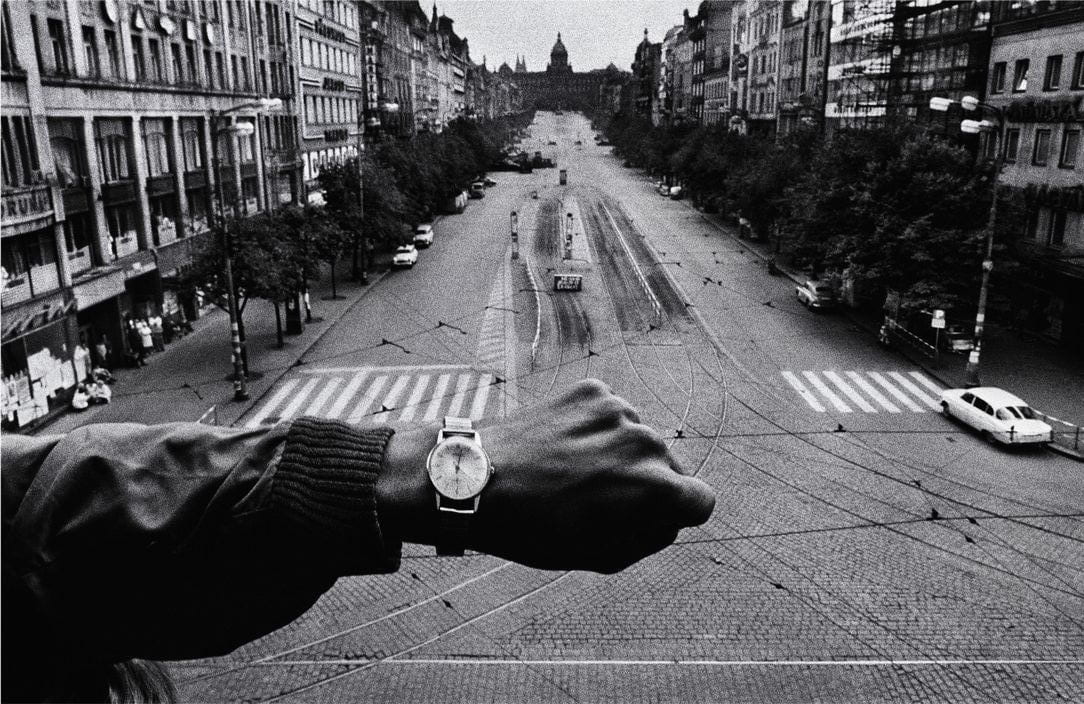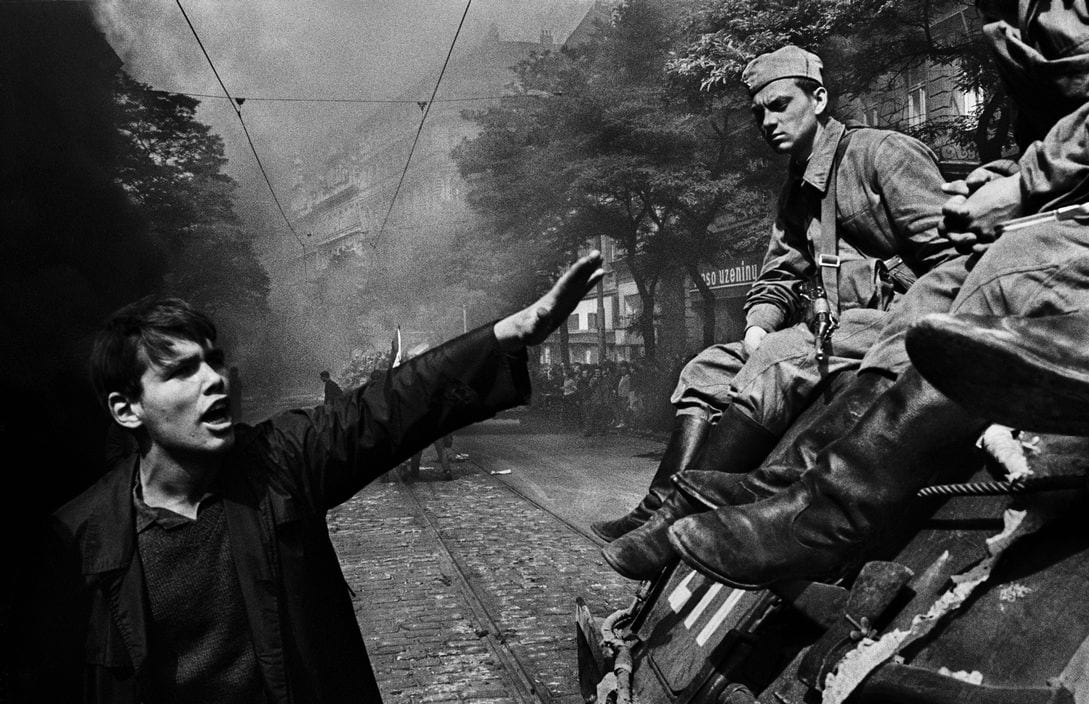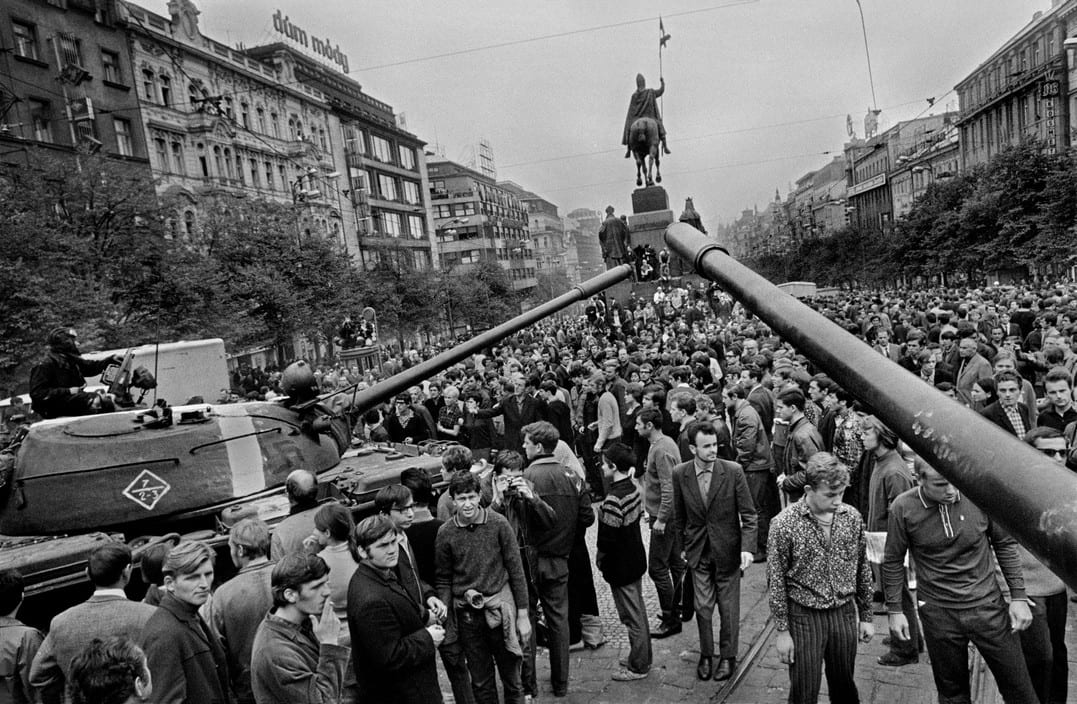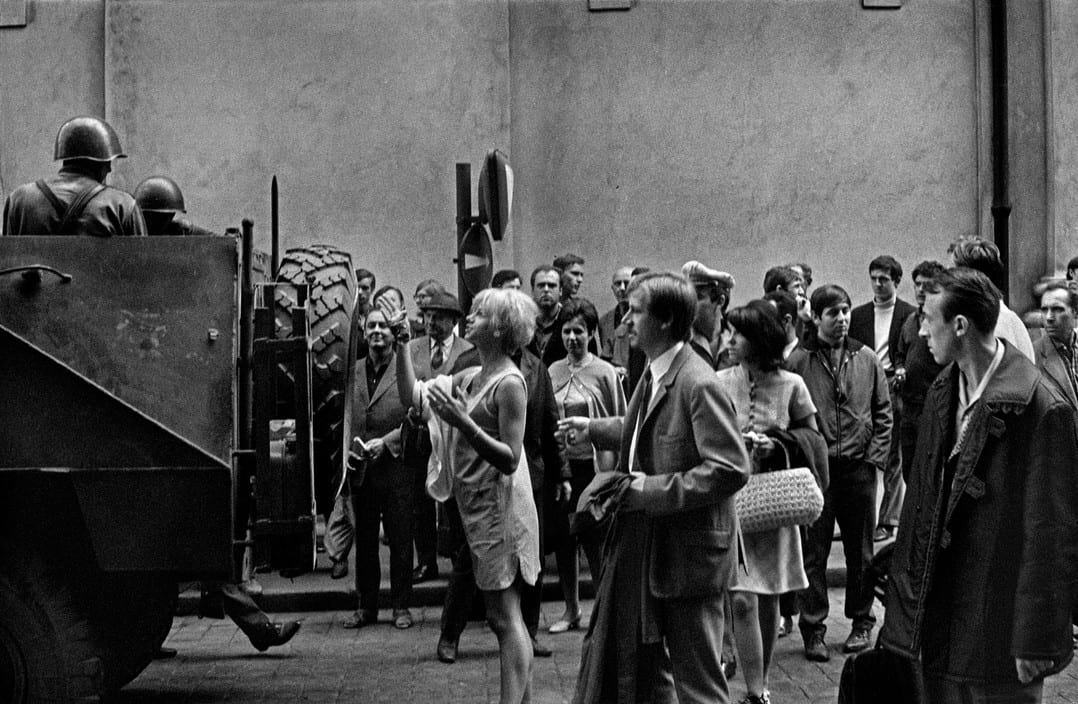by John Raimo
Prague’s famous Wenceslas Square fell silent on August 22nd and 23rd, 1968. Warsaw Pact troops invaded what was then Czechoslovakia the day prior in order to repress what had come to known as the Prague Spring. Under Alexander Dubček’s leadership, the country’s communist party had earlier initiated reforms aiming towards ‘socialism with a human face.’ The crisis this provoked and its violent repression only gradually subsided into ‘normalization’ and an uneasy status quo held until the Velvet Revolution of 1989. Increasing tension saw curfews and peaceful confrontations lead to outright military force exercised upon Czechoslovakian citizens and blanket censorship of news. Images lived on, however.

Josef Koudelka, “CZECHOSLOVAKIA. Prague. August 1968. Warsaw Pact troops invade Prague.” © Magnum Photos
Many western thinkers took the Prague Spring for the end of time. That is, the 1968 invasion of Czechoslovakia was understood to mark the end of communism as a viable historical possibility. In the pages of Le Figaro, Raymond Aron systematically reduced the Prague Spring to an “impossible conversion” rendering the future itself moot. Hannah Arendt anticipated a simple, grim waiting game. “The head-on clash between Russian tanks and the entirely nonviolent resistance of the Czechoslovak people is a textbook case of a confrontation between violence and power,” she wrote in 1970. “To substitute violence for power can bring victory, but the price is very high; for it is not only paid by the vanquished, it is also paid by the victor in terms of his own power.” From the left, Costa-Gavras’s L’Aveu (co-written by the former Czech deputy minister of foreign affairs Artur London and Jorge Semprún; 1970) ended with a “new era” dawning on communist Czechoslovakia. A montage of still photography and movie footage of the invasion concluded the film, much of it was taken on the scene by Chris Marker. He revisited the episode in On vous parle de Prague : Le deuxième procès d’Artur London (1971) and Le fond de l’air est rouge (1977) in structuring a larger argument that social revolution had passed from Soviet-sponsored communism to radical, Third World socialist movements.
https://youtu.be/nmOh9nEUEjI?t=1m41s
The military invasion and occupation of Prague yielded many iconic pictures, not least the recurrent image of civilians facing tanks in a recognizably European cityscape. Nevertheless, the most celebrated representation of the Prague Spring may be the one above taken by Josef Koudelka, a young photographer who took over five thousand photos of Prague in the week beginning on August 21st. Something ambiguous occurred here. As the Večerni Praha (Prague Evening News) reported, “Yesterday’s appeal to clear Wenceslas Square, where a huge demonstration against the occupiers was supposed to take place and could have become a welcome pretext to declare marshal law, was an example of the outstanding qualities of the people of Prague in these eventful days.” After the square’s clearance, “[a]lmost no civilians remained there. Absolute silence spread over the square, which only a few minutes earlier had been full of noise” and the daily bustle. Heavy shooting nearby had been reported on the 21st. Yet the photo’s stark formal composition and resonant symbolism makes a non-event of sorts into an event. Time appeared to literally stop at roughly half-past noon on August 23, 1968.

Josef Koudelka, “CZECHOSLOVAKIA. Prague. August 1968. Invasion by Warsaw Pact troops in front of the Radio headquarters.” © Magnum Photos
The Western notion of what occurred in Prague came at a greater distance, with Marker proving a notable exception. First-hand accounts and photography in particular only slowly breached the Iron Curtain. This opened up in turn a curious story of chronology and reception. For many, Koudelka’s photography of crowds, tanks, graffiti, and buildings pockmarked by bullets determined what had happened. Not many other images traveled outside of the country; indeed, only ten of Koudelka’s photos were smuggled out to the Magnum Photo agency and seen before the exhibit Invasion 68: Prague some forty years later. Excepting a handful of photos taken by fellow Magnum photographer Ian Berry, Koudelka’s award-winning photography became the first visual record of the Prague Spring’s repression. They immediately proved without a doubt the lie of “fraternal help” distributed by Soviet propagandists. Moreover, Koudelka’s work also became the canonical historical record in the west’s imagination. The images wrote a certain history.

Josef Koudelka, “CZECHOSLOVAKIA. Prague. August 1968. Warsaw Pact tanks invade Prague.” © Magnum Photos
Koudelka’s photos lent themselves to greater historiographical and intellectual divides. Westerners were not wrong to read a universal, Cold War history into those same ten images. As the photographer later conceded, their juxtaposition of violence and a historical record carried a “universal value” and “significance beyond Czechoslovakia.” An inherent abstraction emerged. “In [the photos] it is not so important who is Russian and who is Czech,” Koudelka claimed in 2008. “It is more important that one man has a gun and one man has not.” The initial ten photographs accord with the Prague Spring’s evident historical finality: peaceful, middle-class protestors encounter only armed soldiers, and revolutionary gestures recycled from romantic thought and Communist iconography go on to meet gunfire.

Josef Koudelka, “CZECHOSLOVAKIA. Prague. August 1968. Invasion by Warsaw Pact troops. Near the Radio headquarters.” © Magnum Photos
At the same time, the full range of Koudelka’s photography documented a much more open historical narrative. Five thousand photographs capture a range of personal experiences. Families, bored onlookers, young soldiers, and daily life held their weight beside the tanks. An elderly worker with a suitcase heaves a brick at the occupiers before continuing on to work. The photographs captured a fast-moving “complexity” immediately effaced by both the Soviets and, paradoxically, Westerners in the Prague Spring’s aftermath. As Koudelka later made clear, the Prague Spring had been experienced serially and individually by Czechs and Slovaks: experience itself and the imperative to remember undercut any larger eastern or western narrative.
All the same, the sheer aesthetic power and immediacy of Koudelka’s photography cannot be denied on its own terms. Historians encounter here a subtle tangle of methodological issues. There is a question of orientation: recovered contexts might limit formal or aesthetic interpretation, and vice-versa. Josef Koudelka’s photography obviously calls for both movements. It’s not quite the difference between history and art history because the chosen starting point and means of crossing over will change the reading. What we find nevertheless is that firsthand experience and later receptions (moments or decades later) do not easily share the same focus. That gap or disjunction may then prove the final subject for historians of all stripes—intellectual or otherwise—looking to Koudelka’s great record of one end to several times in 1968.

Josef Koudelka, “CZECHOSLOVAKIA. Prague. 21 August 1968. Warsaw Pact tanks invade Prague.” © Magnum Photos
The pleasures and challenges of studying twentieth century history include working with living memory. It would be wonderful to hear from readers who experienced the Prague Spring at first-hand or from a distance; I’m particularly keen to hear what images first made their way to the west and later made their way back to then-Czechoslovakia. The author also thanks S.G. and R.J. for key references.




1 Pingback